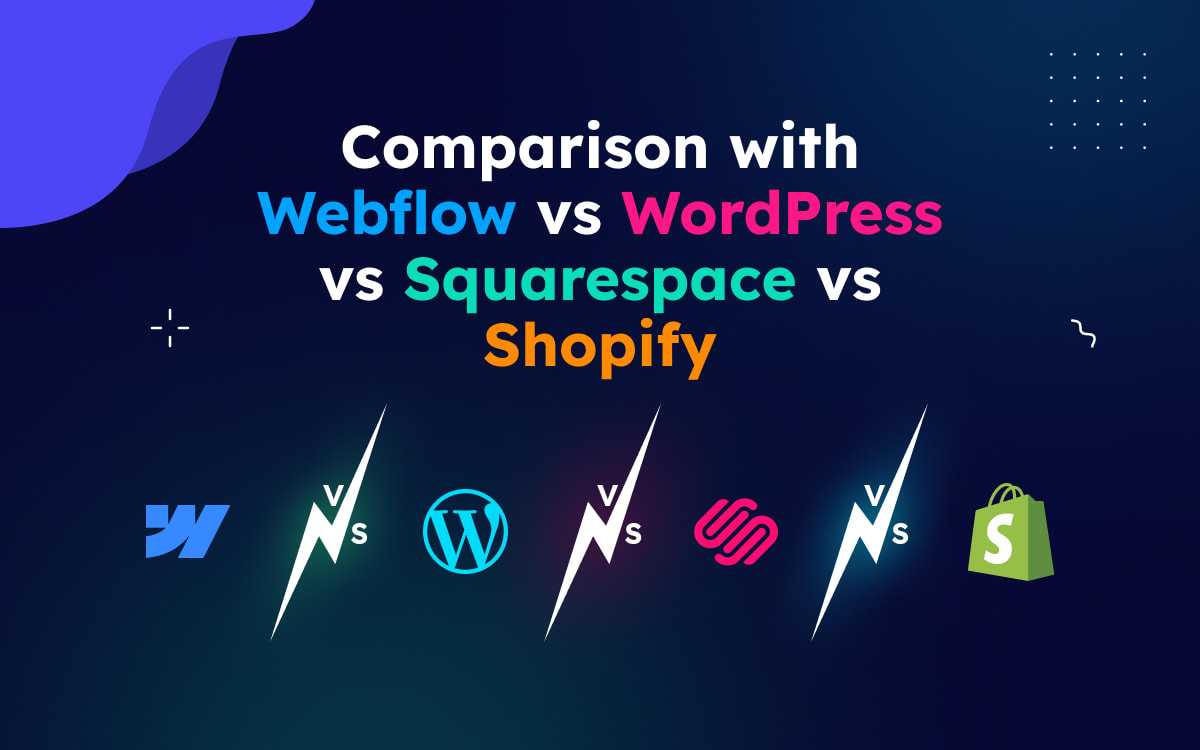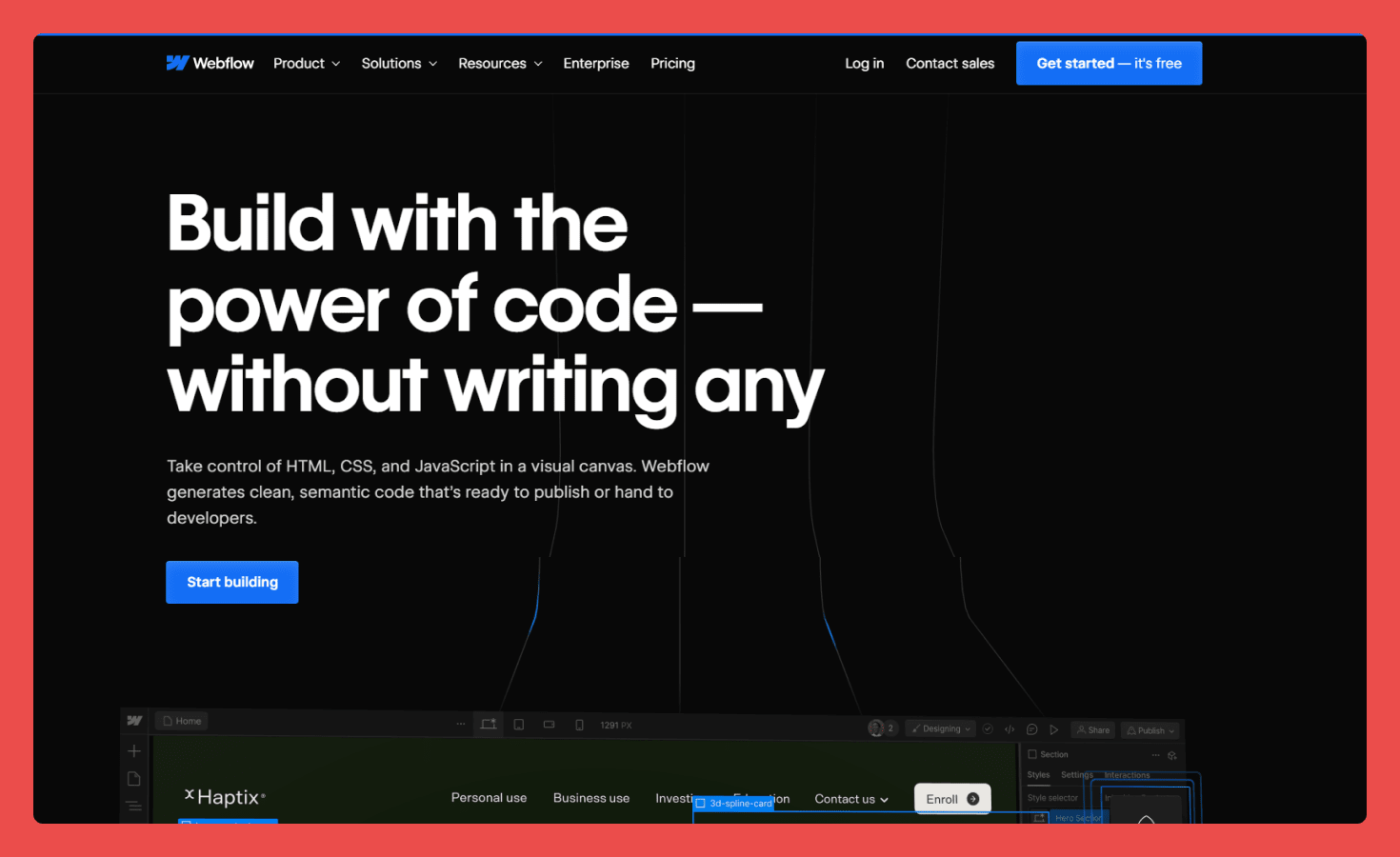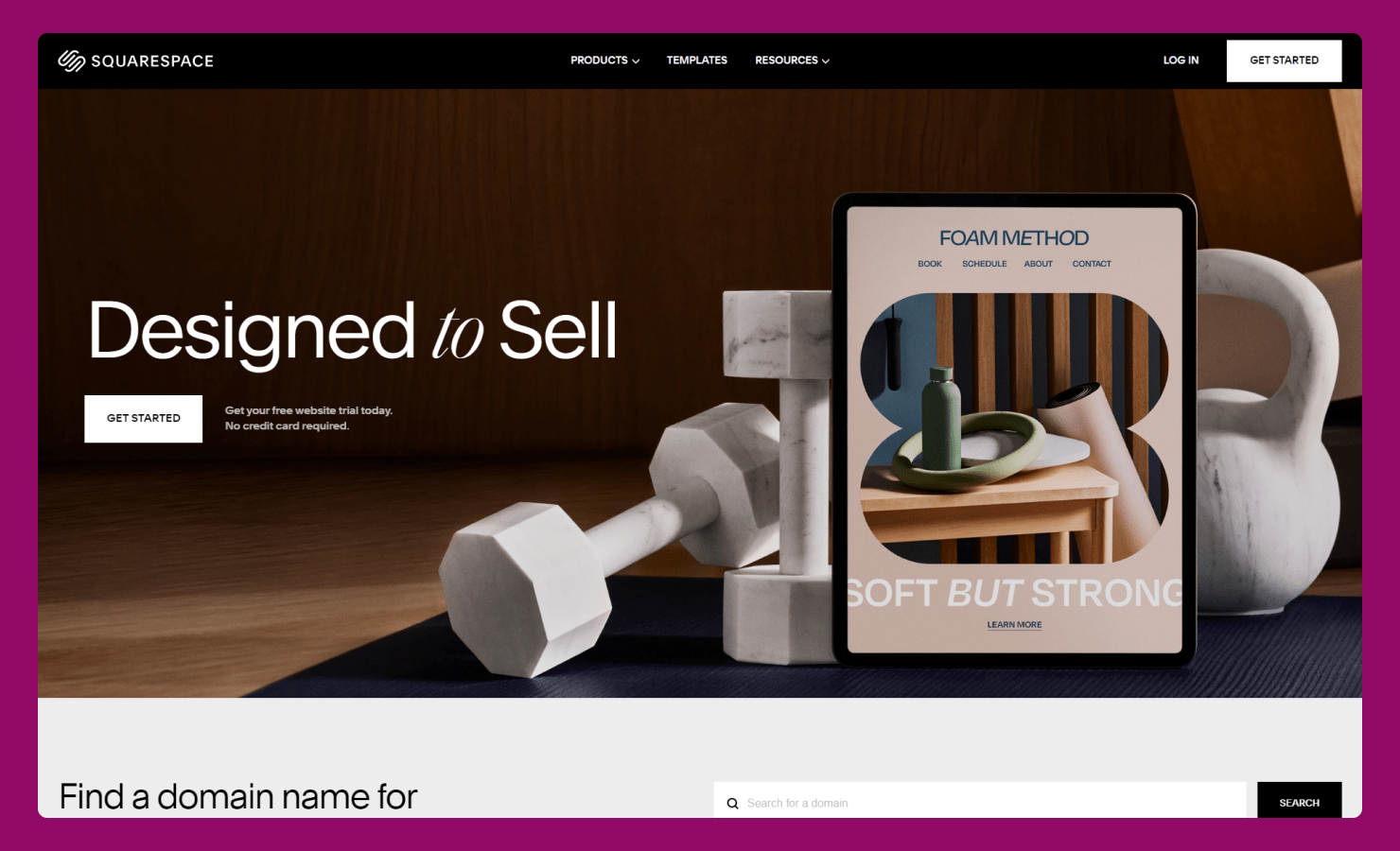Webflow vs WordPress vs Squarespace vs Shopify Which is the best CMS for your website?
Explore the best CMS for your website with this comprehensive comparison of Webflow, WordPress, Squarespace, and Shopify. Find the perfect platform to suit your needs and goals.

In today's digital world, having a website is crucial for businesses and individuals alike. But with so many Content Management Systems (CMS) on the market, choosing the right CMS for your website is crucial.
It determines how easily you can create, manage, and scale your online presence. With so many options available, it's overwhelming to decide which CMS is best suited for your needs.
In this blog, we will compare four popular CMS platforms: Webflow, WordPress, Squarespace, and Shopify, across various parameters to help you make an informed decision.
You will learn from this blog:
- Introduction of the blog
- Understanding Your Needs
- Introduction to CMS Platforms
- Comparison of CMS
- Summary of the Blog
- FAQs
Understanding Your Needs
Before diving in, consider your website's purpose and technical expertise. Are you a design professional seeking complete creative control?
Do you prioritize ease of use and a beginner-friendly interface? Is your primary focus on building an online store? Identifying your priorities will guide your choice.
Consider These Factors Before You Decide:
- Technical Expertise: Are you comfortable with a bit of a learning curve, or do you prefer a drag-and-drop interface?
- Customization Needs: Do you need a highly customized design, or are you happy with a pre-built template?
- Budget: How much are you willing to spend on your website?
- Website Purpose: Are you creating a blog, portfolio, online store, or something else entirely?
Introduction to CMS Platforms
Explore the top CMS platforms: Webflow, WordPress, Squarespace, and Shopify. Learn about their unique features and find out which one suits your website needs best. Our exploration of the future of blogging highlights how ghost platforms play a critical role in empowering creators to build dynamic, engaging, and scalable websites.
1. Webflow: The Design Powerhouse

When evaluating the top platforms, Webflow stands out for many reasons. Check out our list of the top reasons to choose Webflow for your next website. Webflow is a website builder platform that allows users to design, build, and launch responsive websites visually, without writing any code.
It provides an intuitive visual editor that enables users to create custom websites with ease, using drag-and-drop functionality to add and arrange elements on the page.
With Webflow, users have complete control over every aspect of their website's design, including layout, typography, color, and interactions. The platform offers a wide range of customizable templates to help users get started, as well as powerful features such as a content management system (CMS), e-commerce functionality, hosting, and publishing services.
One of the key advantages of Webflow is its ability to generate clean, production-ready code in the background as users design their websites visually. This means that users can create complex, custom websites without needing to write or understand code, while still benefiting from the flexibility and performance of hand-coded websites. Explore the Webflow website creation guide for step-by-step instructions.
Here are the key features of Webflow:
- Visual development interface
- Customizable Templates
- Responsive design
- CMS functionality
- E-commerce Functionality
- Hosting and Publishing
- SEO Tools
- Interactions and Animations
- Collaboration Tools
- Powerful Integrations
Pros of Webflow:
- Unmatched design flexibility
- Clean, user-friendly interface for editing
- Extensive design customization options
- Scalable for various website needs
- Community Support
- Strong Security and Scalability
Cons of Webflow:
- Steeper learning curve compared to some competitors
- Dependency on Webflow Hosting
- Ecommerce functionality comes at an extra cost
Ideal for: Who want full control over their website's design, need advanced features, require responsiveness, and prefer not to code.
2. WordPress

WordPress continues to be a strong choice for CMS users. Discover the most sought-after tips for WordPress to optimize its use.
WordPress is a free and open-source content management system (CMS) that allows users to create, manage, and publish websites and blogs.
Originally launched in 2003 as a blogging platform, WordPress has since evolved into a versatile CMS used by millions of websites worldwide.
WordPress is written in PHP and uses a MySQL database. It provides an intuitive user interface, making it easy for users of all skill levels to create and manage websites without the need for coding knowledge.
WordPress offers a wide range of features and customization options, including thousands of free and premium themes and plugins that allow users to customize their websites to suit their needs.
It offers a range of tools and techniques to optimize WordPress website speed, making it a strong contender for high-performing websites.
Here are the key features of WordPress:
- Large plugin and theme ecosystem
- Content management system
- Blogging functionality
- E-commerce Integration
- SEO capabilities
- Community Support
- Open-source and customizable
Pros of WordPress:
- Huge community and support resources
- Unmatched flexibility with themes and plugins
- Free and open-source software
Cons of WordPress:
- Requires some technical knowledge for setup and maintenance
- Security vulnerabilities can be a concern
- Can feel overwhelming for beginners
- Dependency on Plugins
- Customization Limitations:
Ideal for: Businesses and individuals wanting complete control and customization over their website.
3. Squarespace

Squarespace is an all-in-one website building and hosting platform that allows individuals, businesses, and organizations to create professional-looking websites without the need for coding knowledge. It provides users with an intuitive drag-and-drop interface, customizable templates, and a range of built-in features, including blogging tools, e-commerce functionality, analytics, and more.
With Squarespace, users can easily create and customize websites to suit their needs, whether they're building a personal blog, portfolio, online store, or business website. Squarespace's templates are fully responsive, meaning they look great on all devices, and its built-in features make it easy to manage and update website content.
Here are the key features of Squarespace:
- Drag-and-drop website builder
- Pre-designed templates
- E-commerce functionality
- Domain and hosting services
- Analytics and marketing tools
Pros of Squarespace:
- Easiest to use for beginners
- Beautiful, pre-designed templates
- Built-in e-commerce functionality
Cons of Squarespace:
- Limited design customization compared to others
- Fewer app integrations than WordPress
- Pricing can be higher for complex needs
Ideal for: Entrepreneurs, bloggers, and small businesses seeking a user-friendly platform to create a professional website or online store.
4. Shopify

Shopify is an all-in-one platform designed to empower businesses of all sizes to launch and manage their online stores. It offers a comprehensive suite of features specifically designed for e-commerce, including product management, inventory control, and secure payment processing. With a focus on ease of use and scalability, Shopify makes setting up and running an online store a breeze.
Here are the key features of Shopify:
- Easy to Use Online Store Builder
- Customizable online store
- Multiple Sales Channels
- Payment processing
- Inventory management
- Marketing and SEO tools
- Hosting and Security
Pros of Shopify:
- Feature-rich platform specifically designed for e-commerce
- Easy to set up and manage your online store
- Scalable to accommodate business growth
- Analytics and Reporting
Cons of Shopify:
- Limited flexibility for building non-e-commerce websites
- Transaction fees associated with sales
- Design customization is more restricted
Ideal for: Businesses and individuals who want to create a professional, feature-rich online store.
Comparison Table
Here is the comparison table of Webflow vs WordPress vs Squarespace vs Shopify:
| Features | Webflow | WordPress | Squarespace | Shopify |
|---|---|---|---|---|
| Ease of Use | Offers a user-friendly visual interface, but may have a steeper learning curve for beginners. | Easy to use, especially for beginners, but can become more complex when adding plugins and customizations. | Extremely user-friendly with its drag-and-drop interface and pre-designed templates. | Designed specifically for e-commerce, so it's straightforward and easy to use for online store management. |
| Design | Offers complete design flexibility with its visual editor, allowing for highly customized and unique designs. | Offers thousands of themes and plugins for customization, but may require coding for extensive customization. | Known for its stunning templates and highly polished designs, but customization options are limited compared to Webflow. | Provides a range of customizable templates specifically designed for e-commerce, but customization options are somewhat limited compared to Webflow. |
| E-commerce | Offers e-commerce functionality, but may not be as robust as Shopify. | Requires plugins like WooCommerce for e-commerce functionality, but offers extensive customization options. | Built-in e-commerce functionality with easy-to-use tools for managing an online store. | Specifically designed for e-commerce, offering everything you need to set up and manage an online store. |
| CMS | Offers a powerful CMS for managing content, including blogs, portfolios, and more. | Known for its robust CMS capabilities, making it easy to manage all types of content. | Provides basic CMS functionality, but may not be as powerful as Webflow or WordPress. | While primarily an e-commerce platform, Shopify also offers basic CMS functionality for managing content. |
| SEO | Offers built-in SEO tools and allows for full control over SEO settings. | Offers a range of SEO plugins and allows for extensive customization of SEO settings. | Provides basic SEO tools and allows for some customization of SEO settings. | Offers basic SEO tools, but may not be as customizable as Webflow or WordPress. |
| Freedom | Offers complete design freedom and control over every aspect of your website. | Offers a high degree of freedom and customization options, but may require coding knowledge for extensive customization. | Provides less freedom compared to Webflow or WordPress, but still offers a range of customization options. | Offers limited freedom compared to Webflow or WordPress, especially for non-e-commerce websites. |
| Scalability | Highly scalable, suitable for small websites to large, complex projects. | Highly scalable, suitable for small blogs to large enterprise websites. | Less scalable compared to Webflow or WordPress, better suited for small to medium-sized websites. | Highly scalable for e-commerce websites, but may not be as suitable for other types of websites. |
| Pricing | Offers a range of pricing plans starting from $14/month for basic websites and $23/month for CMS hosting. Business plans start from $39/month. Check https://webflow.com/pricing. | Free to use, but you'll need to pay for hosting, domain registration, themes, and plugins. Costs can vary depending on your needs. You can check WordPress pricing https://wordpress.com/pricing/. | Offers pricing plans starting from $16/month for personal websites and $23/month for business websites. E-commerce plans start from $28/month. https://www.squarespace.com/pricing to see all pricing. | Offers pricing plans starting from $19/month for basic online stores and $49/month for a small teams. https://www.shopify.com/pricing to see all pricing. |
Summary
While each CMS has its own strengths and weaknesses, Webflow stands out as the best option for most users. It offers unmatched design flexibility, powerful CMS functionality, and scalability, making it suitable for a wide range of websites, from small blogs to large e-commerce stores. Additionally, Webflow's pricing is competitive, especially considering the features and flexibility it offers. However, if you're specifically looking to set up an online store, Shopify might be the better option due to its specialized e-commerce features. Ultimately, the best CMS for you will depend on your specific needs and preferences.
FAQs
Do you have any questions about comparison with Webflow vs WordPress vs Squarespace vs Shopify? We have answers to some frequently asked questions on the topic.
Which CMS is the easiest to use?
Basically all CMS are easiest to use. Webflow and Squarespace are known for their user-friendly interfaces and simple drag-and-drop editors, making them ideal for beginners.
Which CMS is the most customizable?
Webflow and WordPress offer the highest level of customization, allowing users to create custom designs themes, and add features using a variety of tools and integrations.
Which CMS is the best for SEO?
All four CMS platforms offer a range of SEO features to help users optimize their websites for search engines. However, Webflow and WordPress is known for its robust SEO capabilities.




